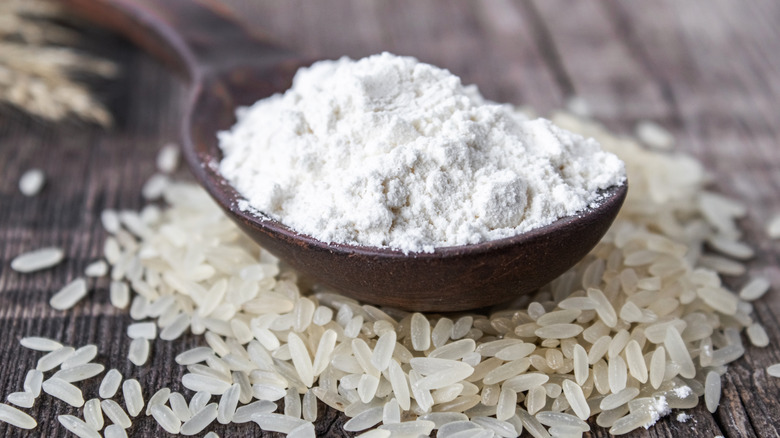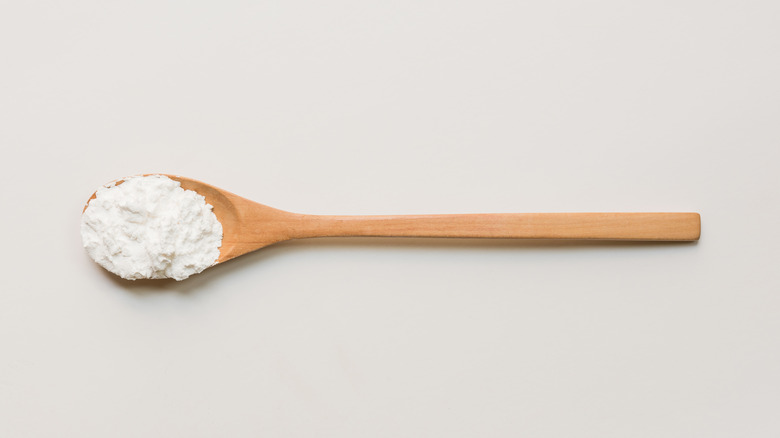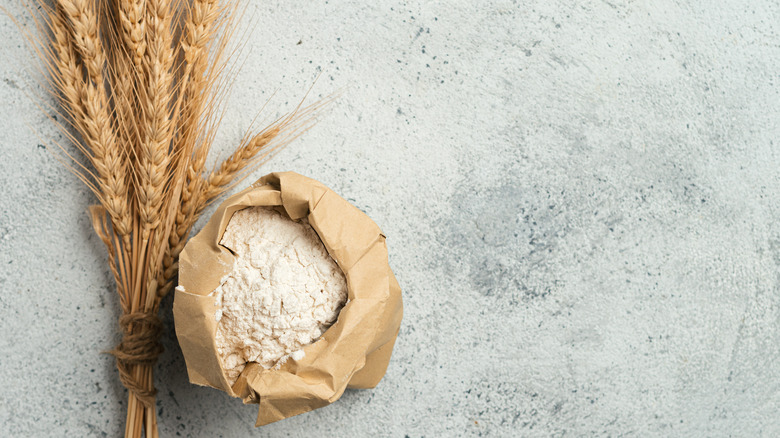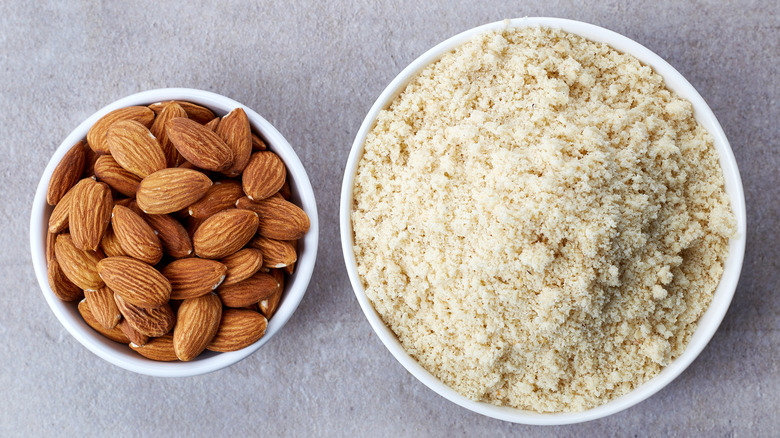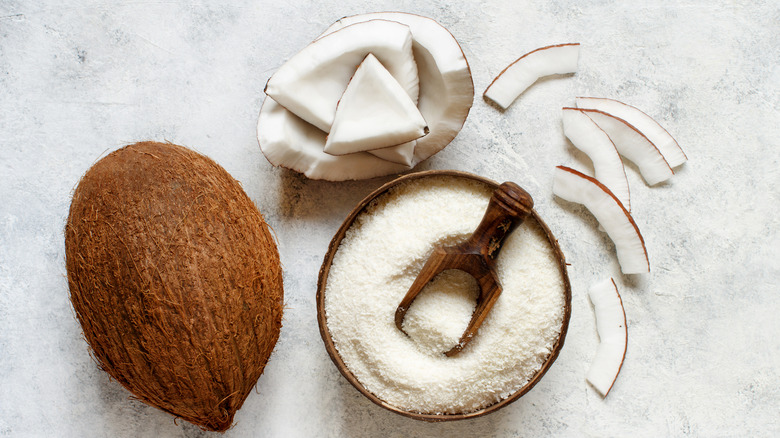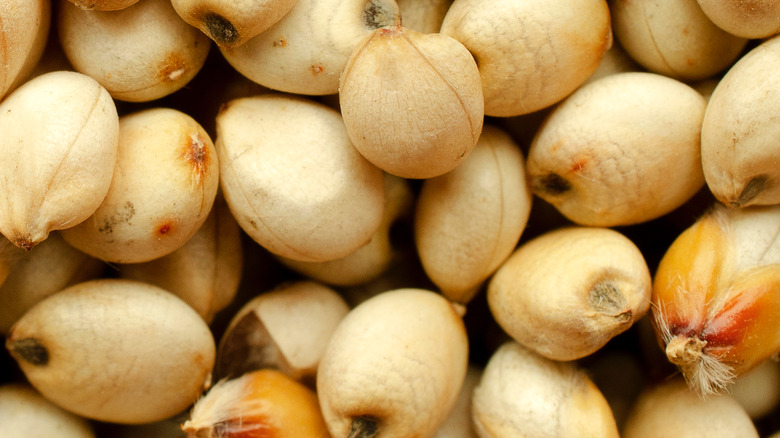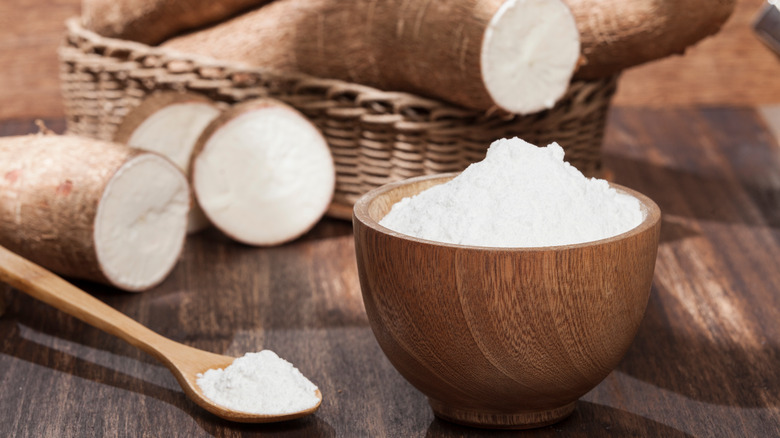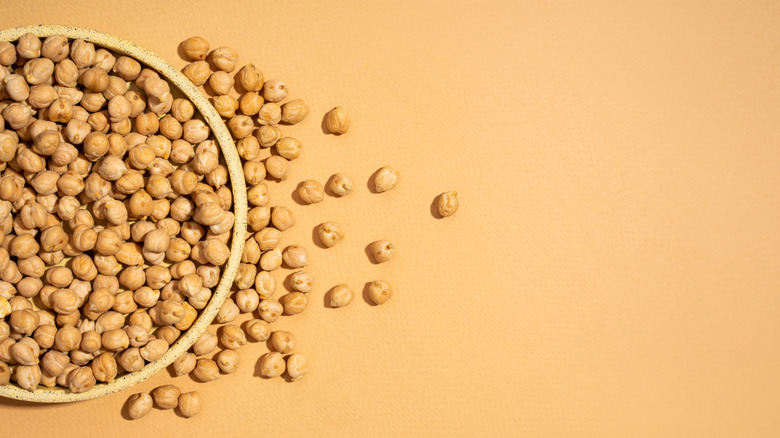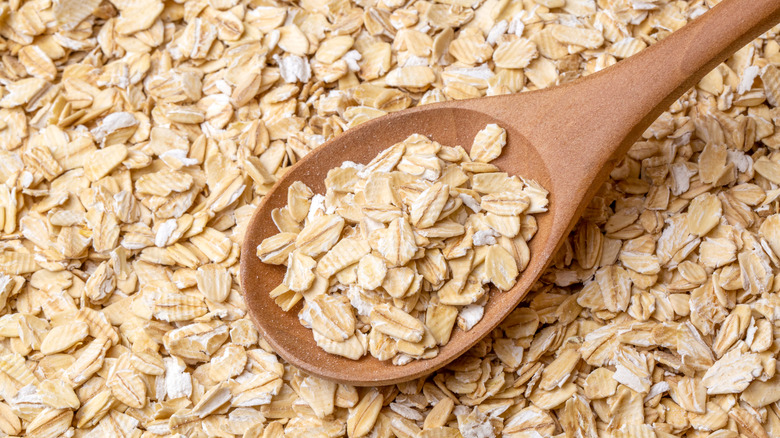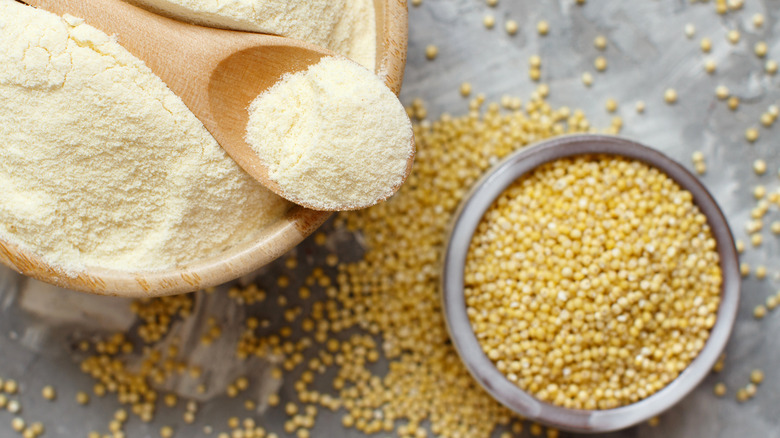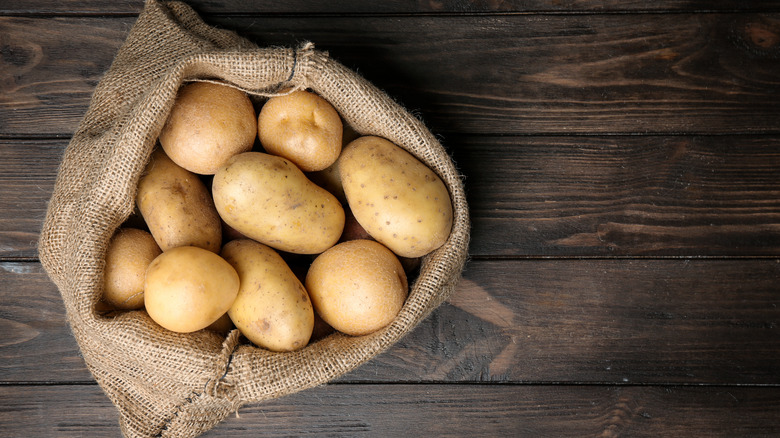10 Best Substitutes For Rice Flour
We may receive a commission on purchases made from links.
As its name suggests, rice flour is made from finely ground rice, which produces a powder that can be used for baking of all kinds. But here's why it's so great: It's one of the few incredibly versatile and cheap gluten-free flours for anybody with gluten intolerance or celiac disease (via Kitchenville).
In fact, the use of rice flour is quite common in Asian cuisine, treasured for its ability to add lightness while still giving the dish a chewy mouthfeel — as opposed to other flours that can't offer the same, says MasterClass. Rice noodles, for example, are made with rice flour and so is the batter for tempura. Rice flour is often also a sought-after option to use in gluten-free baked goods because it gives much needed structure to delicate treats, despite having no gluten at all.
Considering you can get rice in two main types of grain — white and brown — rice flour too can either be milled from white rice or brown rice, notes My Recipes. Then, there's also glutinous rice flour which is made from sticky rice, mostly used to make the sweet Japanese treat mochi. While you could use both brown rice flour or white rice flour depending on what you prefer, the former does have a slight edge with an added nutty taste — and it tends to be more nutritious than white rice flour.
So, depending on what you're using it for — dumplings or rice noodles, breads or gluten-free desserts, an airy tempura batter, or even thickening a sauce — there are many ways to substitute rice flour when you run out or want to try something new.
1. Cornstarch
Cornstarch may not be the healthiest substitute for rice flour, but it is the most ideal if you're looking for a substitute to thicken a sauce or gravy. Plus, it's a gluten-free substitute too (via Survival Freedom). As with rice flour, cornstarch has no taste on its own so you can add it to your sauces without worrying about any unnecessary flavor.
Cornstarch is also an excellent substitute for rice flour if you're using it for frying. Coat your chicken, veggies, potatoes (or whatever it is that you wish to fry) in cornstarch and be prepared to experience a nice crunch when it's done cooking.
When using cornstarch to thicken a sauce, Kitchenville suggests keeping a few things in mind. With rice flour, you could add the flour directly into a liquid and it'll thicken instantly. With cornstarch, however, you need to add some water to it first and then add the cornstarch slurry to your sauce or gravy, simmer on low heat, and let it gradually thicken.
You can use a 1:1 ratio to substitute rice flour with cornstarch, but make sure to turn the cornstarch into a slurry first before you mix it into a gravy or sauce.
2. All-purpose flour
Another good rice flour substitute for thickening gravies or sauces, and one that's more likely to be stocked in your pantry at all times, is all-purpose flour. Unlike cornstarch though, all-purpose flour is generally not a gluten-free substitute — though there are gluten-free options available like this one from Bob's Red Mill. To use all-purpose flour as a thickening agent, like cornstarch, it needs to be added to a sauce or gravy in a liquid form. Make sure to add a bit of water to the flour first to turn it into a slurry and let it simmer in order to let the liquid gradually thicken.
The good thing about all-purpose flour, though, is that you can use it as an alternative to rice flour in pretty much any dish. Considering most baked goods are made using all-purpose flour, it's a no-brainer to substitute it for rice flour when baking, especially if you can get your hands on the gluten-free option. And easy enough, the swap can usually be done in a 1:1 ratio.
3. Almond flour
Made by blitzing blanched nuts, almond flour is another suitable rice flour substitute that's also gluten-free. Plus, it's an equally nutritious flour to use, if not more. Per Healthline, a one-ounce serving of almond flour makes up for a good chunk of your daily nutritional intake of various nutrients, particularly vitamin E, which has been studied for its possible ability to reduce the risk of Alzheimer's, as well as manganese, which may lower blood pressure and regulate blood sugar.
Almond flour is a great substitute to use in place of rice flour particularly when baking, says Survival Freedom. While it does have a slightly nutty taste of its own, that's nothing a bit of chocolate or vanilla can't mask. You could also use almond flour as a coating when frying foods, however, when doing so, make sure to keep a close eye on it as almond flour can burn easily. Alternatively, you could coat your food in almond flour and then bake it for an equally crispy end result without the risk of burning the dish.
Per Substitute Cooking, the ratio for substituting almond flour with rice flour isn't set in stone, however, following a 1:1 ratio is a safe bet.
4. Coconut flour
While almond flour is a healthy and gluten-free alternative to rice flour, it's not suitable for those with nut allergies. Coconut flour, on the other hand, is a more ideal option in this case. A ground powder made from dry coconut flesh, coconut flour may even help stabilize your blood sugar levels, and is rich in fiber, which can aid digestion and possibly help with weight loss (via Healthline). Not to mention, coconut flour has a lovely tropical aroma.
Since coconuts are naturally sweet, coconut flour is best used in place of rice flour in sweet desserts, says Survival Freedom. Be sure to cut back on any additional sugar that you add to your recipe when using this substitute. Additionally, coconut flour is also very absorbent, meaning it can absorb all the liquid from your batter leaving the final baked treat more dry and grainy than moist and spongey. So, you should add more liquid in your recipes when using coconut flour if that is a concern.
When substituting rice flour with coconut flour, use half the amount of coconut flour. That is, if a recipe calls for two cups of rice flour, you need just one cup of coconut flour.
5. Sorghum flour
Sorghum flour may not be everyone's cup of tea. On one hand, this gluten-free option is milled from the grain sorghum, which is rich in nutrients. Per Healthline, sorghum is high in fiber, antioxidants, and vitamin B, which improves skin and hair. The website also notes that sorghum is an excellent source of protein, right in line with quinoa.
Despite its health benefits, however, sorghum flour has an inherently intense and bold flavor that can easily overpower all other flavors in your dish, making the end result sometimes bitter, says Survival Freedom. However, it does a good job in helping breads and cakes rise when added to baking recipes, even better than rice flour, says the source. If you do wish to use sorghum flour as a substitute for rice flour, you could use it in addition to other flours or sweeteners in order to minimize its bitterness.
For best results, use a 1:1 ratio to substitute rice flour with sorghum flour (and add in additional components to taste).
6. Tapioca flour
Tapioca flour is made from the root of the cassava plant, and it's the same flour that is used to make the much-loved chewy tapioca balls present in boba tea. Per Substitute Cooking, if you're on a tight budget, tapioca flour is probably the cheapest rice flour substitute that you can find.
It has little taste or smell on its own so you can use it for pretty much anything except frying. Use it to thicken gravies or make sauces extra creamy. However, tapioca flour thickens a lot and very quickly too, so make sure to add it gradually to any liquid. You can also add this gluten-free flour to baked goods as it can make doughs chewy (similar to tapioca balls) and crusts crunchy. Tapioca flour is a tad sweeter than rice flour though, so you might want to tweak the amount of sugar added in the recipe to adjust for taste.
To substitute tapioca flour for rice flour in your recipe, use a 2:1 ratio. That is, for every cup of rice flour required, swap in two cups of tapioca flour instead.
7. Chickpea flour
When you think of gluten-free flours to substitute for rice flour, one made from chickpeas is probably not the first thing that comes to mind. However, per Healthline, the legume-based alternative has long been used in Indian cuisine and is packed with all the same health benefits of chickpeas. One cup of chickpea flour, says Healthline, contains 101% of your daily recommended folate intake, which helps during pregnancy. It's also high in protein, fiber, manganese, and a ton of other nutrients.
Unlike most other gluten-free flours, chickpea flour is a great binding agent but doesn't rise too well, so it works best in recipes for pancakes, tortillas, and other flat bakes, notes Survival Freedom. Though, be prepared for a subtle chickpea-like taste in your dish. Another thing to keep in mind when using chickpea flour is that it can absorb a lot of liquid and can make your batter very sticky.
Use a 1:1 ratio to substitute rice flour with chickpea flour in most recipes.
8. Oat flour
There's no doubt that oat flour is pretty nutritious. In fact, Healthline notes that oats are one of the most nutritious grains that you can eat, with more fat and protein content than most other grains. Safe to say, if you're looking for a healthy substitute for rice flour, oat flour is a great pick. It also helps that you don't need a fancy brand from a specialty store to use this swap. Simply blitz a cup of oats in a blender and you'll have oat flour ready to use (per Minimalist Baker).
Per Substitute Cooking, oat flour works best as a substitute for brown rice flour in particular, especially for baking purposes, as they both have similar nutritional profiles and add the same color in bakes. Plus, oat flour also adds a certain earthiness, giving baked goods a chewy texture, as well as imparting a toasty flavor (via My Recipes).
For best results, use a 1:1 ratio to substitute rice flour with oat flour.
9. Millet flour
While many other rice flour substitutes are most suitable for baking and thickening liquids, millet flour is a great alternative to rice flour when it comes to frying foods. Per Delighted Cooking, millet flour is also a good choice for baking as it can make goods light and fluffy.
Although it resembles wheat flour in appearance, millet flour is suitable for gluten-free diets and happens to be a rich source of protein and various essential nutrients. It's also a good idea to keep in mind that, unlike other neutral-flavored flours, this one also has a sweet and a strong nutty taste, which Survival Freedom compares to the taste of corn.
However, although millet flour can give cakes and breads a nice crumb, they can get a little too crumbly and, as such, this swap is best used in combination with some all-purpose flour.
Per the Academy of Culinary Nutrition, you should mix one-quarter of millet flour with three-quarters of all-purpose flour, to replace one serving of rice flour.
10. Potato starch
Potato starch and rice flour are often used as substitutes for each other. Not to be confused with potato flour, it's made by extracting the starch from potatoes, then drying the starch, and then grinding it into a powder that resembles cornstarch (via All Recipes).
As with cornstarch, if you're looking for a rice flour substitute to fry light, airy, and crispy tempura, Kitchenville suggests that potato starch is the next best thing. In fact, potato starch can be better than rice flour when it comes to frying. You can also use this swap as a dusting flour to use when rolling other doughs to keep them from sticking to the surface.
Tastessence notes that if you're using potato starch to thicken liquids, it's important to remember that this kind is a much stronger thickening agent than rice flour. So, you're going to need a lot less of the potato starch to thicken a liquid.
Per Real Simple, you should make a slurry with one tablespoon of potato starch and two tablespoons of water to produce an ideal swap to thicken one cup of liquid.
